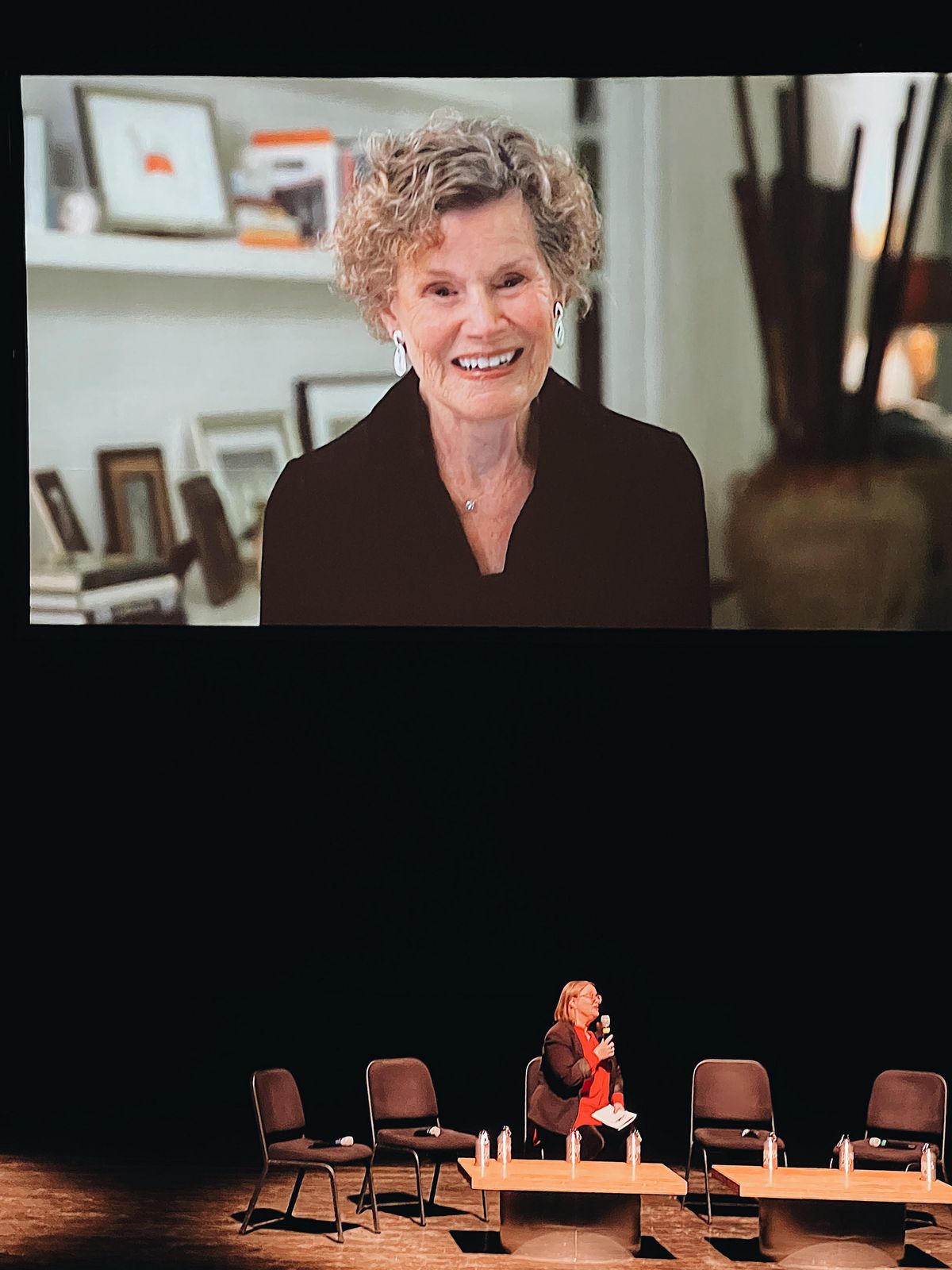Banned Book Awards champions children’s right to read

Judy Blume connected digitally at the ceremony and was honored with a lifetime achievement award.
Alexander Wilburn

Judy Blume connected digitally at the ceremony and was honored with a lifetime achievement award.
There can be no question that democratic freedoms are currently being attacked and restricted in the United States, and somehow, children and the information they have access to have been the ongoing targets of attack.
As AP News reported in 2023: “More than 1,200 challenges were compiled in 2022, nearly double the then-record total from 2021 and by far the most since the American Library Association began keeping data 20 years ago.” Conservative groups across the country have become well-organized machines harassing individual public and school librarians with threats of legal and violent action. The message from these groups, often supported by government leaders, is that children should not have access to books — books meant for young readers — that engage with topics of race, gender or sexual identity.
At Fisher Center at Bard College, the inaugural Eleanor Roosevelt Banned Book Awards was held Saturday night, Feb. 17, honoring a group of middle-grade and young adult authors with the first Awards for Bravery in Literature. These recipients, authors of some of the most challenged books in the country by counties, local governments and school boards, were acknowledged for their literary accomplishments and for championing stories full of independent thought, compassion and important social messages.
The award ceremony was hosted by Anna Eleanor Fierst, Roosevelt’s great-granddaughter and chair of the Eleanor Roosevelt Center at Val-Kill. Fierst was joined on the stage by speakers Emily Drabinski, the president of the American Library Association; George McCalman, author of “Illustrated Black History: Honoring the Iconic and Unseen”; Matt Nosanchuck, the deputy assistant secretary for operations and outreach in the Office for Civil Rights at the U.S. Department of Education; Lee Rowland, policy director at the New York Civil Liberties Union (NYCLU); and Cameron Samuels, a student at Brandeis University and the executive director of SEAT, a youth civic organization. Last year, at age 18, Samuels testified before the Senate Judiciary Committee addressing book bans.
The recipients of the Eleanor Roosevelt Awards for Bravery in Literature were the following, in alphabetical order:
— Laurie Halse Anderson for “Shout: The True Story of a Survivor Who Refused to be Silenced” from Viking Books. Anderson is the author of the 1999 young adult novel “Speak,” adapted into a Sundance Festival film in 2004 starring Kristen Stewart. “Speak” tells the story of a 14-year-old girl who is raped at a party the summer before her first year of high school and finds herself ostracized by her fellow students as she finds the strength to name her assailant. Twenty years later, Anderson wrote “Shout,” a companion memoir about her own adolescence. “Speak” was a National Book Award finalist, but in 2020, was also named the fourth most banned and challenged book in the United States.
— Mike Curato for “Flamer” from Macmillan. A semi-autobiographical graphic novel written and illustrated by Curato, set in 1995, it details a summer at a sleepaway Boy Scouts camp where a 14-year-old Filipino boy navigates changes in his male friend group — which include bullying and homophobic slurs — leaving him isolated, hating himself and contemplating suicide. PEN America reported that “Flamer” was banned in schools in at least six states during the 2021-22 school year, and in Utah’s Alpine School District, was filed as “pornographic.”

— Alex Gino for “Melissa” (previously published as “George”) from Scholastic. “Melissa” has appeared on the American Library Association’s Top Ten Most Challenged Books list every year since its publication. The children’s novel follows a 10-year-old transgender girl named Melissa, known as “George” to her family, whose one wish is to play the role of the talking spider Charlotte in her fourth-grade class’s production of “Charlotte’s Web.” The novel was at the center of the 2018-19 Oregon Battle of the Books controversy, a school reading challenge that two school districts refused to participate in because of the inclusion of “Melissa” on the reading list.
— George M. Johnson for “All Boys Aren’t Blue” from Farrar, Straus and Giroux. A coming-of-age memoir, Johnson details their ’90s youth in Plainfield, New Jersey, with a focus on coming to terms with their Black and queer identity while also addressing Black, queer male readers today as they search for role models and representation in their own lives. In 2021, a Flagler County school board member and a retired teacher filed a criminal complaint against the Florida school’s superintendent for carrying the book.

— Maia Kobabe for “Gender Queer” from Simon and Schuster. The graphic novel written and illustrated by Kobabe has been in the eye of the book-banning storm since its publication, publicly challenged by conservative politicians like South Carolina Gov. Henry McMaster and Virginia Gov. Glenn Youngkin, among others, citing the novel to be “obscene for unrestricted viewing by minors.” In a town hall in 2023, Youngkin was called out on his views on the book and trans youth by a transmasculine Arlington high school student named Niko. “Look at me,” Niko said to Youngkin. “I am a transgender man. Do you really think that the girls in my high school would feel comfortable sharing a restroom with me?”

— Jelani Memory for “A Kids Book About Racism” from Penguin Random House. The young reader’s book for ages 3-6 was initially written for Memory’s own children — his four white step-children and two Black biological children — before he submitted the book for publication. The introduction tells children, “This is a book about racism. For reals! And yes, it really is for kids. It’s a good book to read with a grownup. Because you’ll have lots to talk about afterward.”
The ceremony’s Lifetime Achievement Award was presented by NYCLU’s Lee Rowland to the incomparable author of beloved young adult books, Judy Blume, who joined the audience digitally from her home in Key West, Florida.
Since the publication of “Are You There God? It’s Me, Margaret” in 1970, the name Judy Blume has been synonymous with the inner heart of girlhood. The author of classics like “Blubber,” “Tiger Eyes,” and “Forever...,” Blume has not only captured the complexity of puberty as childhood innocence slips away and the shadow of adulthood looms, but taken the emotions and plights of young girls seriously. Tackling stories centering on faith, death, virginity and love, Blume’s novels continue to be a lifeline to readers grappling with understanding a world that often deliberately hides uncomfortable truths, even when it comes to a girl’s own body and mind.
“As someone who argued with [former White House communications director] Pat Buchanan over masturbation, I’m sorry to say I’ve heard a lot [when it comes to challenging books],” Blume said at the ceremony. “It is different today. It is scarier because it is coming from the government more and more, and from state legislatures. It is very political now. We just have to keep going. We just have to keep working together.”
Her advice to her fellow authors, as well as to young aspiring novelists, was clear: “You’ve got to knock the critic off one shoulder, and you’ve got to knock the censor off the other shoulder. When you’re locked up in your little room writing, you cannot think of what will happen. You just have to go for it.”
The Stone Round Barn at Hancock Shaker Village.
My husband Tom, our friend Jim Jasper and I spent the day at Hancock Shaker Village in Pittsfield, Massachusetts. A cold, blustery wind shook the limbs of an ancient apple tree still clinging to golden fruit. Spitting sleet drove us inside for warmth, and the lusty smells of manure from the goats, sheep, pigs and chickens in the Stone Round Barn filled our senses. We traveled back in time down sparse hallways lined with endless peg racks. The winter light was slightly crooked through the panes of old glass. The quiet life of the Shakers is preserved simply.

Originally founded in England, the Shakers brought their communal religious society to the New World 250 years ago. They sought the perfection of heaven on earth through their values of equality and pacifism. They followed strict protocols of behavior and belief. They were celibate and never married, yet they loved singing and ecstatic dancing, or “shaking,” and often adopted orphans. To achieve their millennialist goal of transcendental rapture, we learned, even their bedclothes had to conform: One must sleep in a bed painted deep green with blue and white coverings.
Shakers believed in gender and racial equality and anointed their visionary founding leader, Mother Ann Lee, an illiterate yet wise woman, as the Second Coming. They embraced sustainability and created practical designs of great utility and beauty, such as the mail-order seed packet, the wood stove, the circular saw, the metal pen, the flat broom and wooden clothespins.
Burning coal smelled acrid as the blacksmith fired up his stove to heat the metal rod he was transforming into a hook. Hammer on anvil is an ancient sound. My husband has blacksmithing skills and once made the strap hinges and thumb latches for a friend’s home.
Shaker chairs and rockers are still made today in the woodworker’s shop. They are well made and functional, with woven cloth or rush seats. In the communal living space, or Brick Dwelling, chairs hang from the Shaker pegs that run the length of the hallways, which once housed more than 100 Shakers.

In 1826, the 95-foot Round Stone Barn was built of limestone quarried from the land of the 3,000-acre Hancock Shaker Village. Its unique design allowed a continuous workflow. Fifty cows could stand in a circle facing one another and be fed more easily. Manure could be shoveled into a pit below and removed by wagon and there was more light and better ventilation.
Shakers called us the “people of the world” and referred to their farm as the City of Peace. We take lessons away with us, yearning somehow for their simplicity and close relationship to nature. One Shaker said, “There’s as much reverence in pulling an onion as there is in singing hallelujah.”
A sense of calm came over me as I looked across the fields to the hills in the distance. A woman like me once stood between these long rows of herbs — summer savory, sage, sweet marjoram and thyme — leaned on her shovel brushing her hair back from her eyes, watching gray snow clouds roll down the Berkshires.
More information at hancockshakervillage.org

Exterior of Lakeville Books & Stationery in Great Barrington.
Fresh off the successful opening of Lakeville Books & Stationery in April 2025, Lakeville residents Darryl and Anne Peck have expanded their business by opening their second store in the former Bookloft space at 63 State St. (Route 7) in Great Barrington.
“We have been part of the community since 1990,” said Darryl Peck. “The addition of Great Barrington, a town I have been visiting since I was a kid, is special. And obviously we are thrilled to ensure that Great Barrington once again has a new bookstore.”
The second Lakeville Books & Stationery is slightly larger than the first store. It offers more than 10,000 books and follows the same model: a general-interest store with a curated mix of current bestsellers, children’s and young readers’ sections; and robust collections for adults ranging from arts and architecture, cooking and gardening, and home design to literature and memoirs. Anne reads more than 150 new titles every year (as many as a Booker Prize judge) and is a great resource to help customers find the perfect pick.
A real-time inventory system helps the store track what’s on hand, and staff can order items that aren’t currently available. There is also a selection of writing and paper goods, including notecards, journals, pens and notebooks, as well as art supplies, board games, jigsaw puzzles and more. The owners scour the stationery trade shows twice a year and, Darryl says, “like to tailor what we offer to suit the interest of our customers in each market.”
The Pecks know what it takes to run a successful local enterprise. Darryl has a 53-year background in retail and has launched several successful businesses. He and Anne owned and operated a bookstore on St. Simons Island, Georgia, from 2019 to 2025. They are tapping into their local roots with both stores. They raised their family in Sharon, and their daughter Alice, a native of the Northwest Corner, manages the Lakeville store.

The family values the role that a retail store plays as a supporting partner in the community, and they prioritize great management in both locations, hiring and training talent from local communities. Their 10 team members across both stores are from the area, and two of the Great Barrington employees previously worked at Bookloft.
Darryl and Anne’s attention to customer service is everywhere apparent and adds to the enjoyable and irreplaceable in-store shopping experience. The books are in pristine condition, eliminating the risk of damage that sometimes occurs during shipping. This is especially important for books that will live on people’s shelves and coffee tables for years.
Darryl says, “People love the in-store discovery — you find books you didn’t know existed, which is very difficult to do on a website. Also, many customers depend on our recommendations when visiting. There is a saying about bookstores versus online ordering: We may not have exactly what you were looking for, but we have what you want.”
Lakeville Books & Stationery’s Great Barrington store is open 7 days a week, Monday-Saturday, 10 a.m. to 6 p.m., and Sunday, 11 a.m. to 5 p.m. Parking is available in the lot behind the building and in the parking lot behind the firehouse. The entrance to the store is accessible from the store parking lot.
For more information, go to lakevillebooks.com., and sign-up for the Lakeville Books newsletter.
Richard Feiner and Annette Stover have worked and taught in the arts, communications, and philanthropy in Berlin, Paris, Tokyo and New York. Passionate supporters of the arts, they live in Salisbury and Greenwich Village.